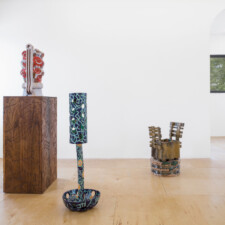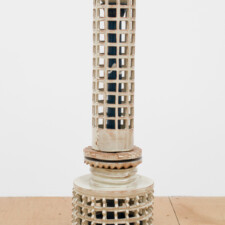Fantasy Pieces: Decorative Garments for the Home at Nina Johnson Gallery
September 28th – November 18th, 2023

PRESS RELEASE
(MIAMI, FL — September TK, 2023) — Nina Johnson is pleased to present Fantasy Pieces: Decorative Garments for the Home, a solo exhibition featuring eleven new mixed-media, ceramic-based sculptures by artist Bari Ziperstein. Opening September 28th in the Upstairs Gallery, the artist’s latest body of work examines the political and material cultures of turn of the century Viennese Design and the Wiener Werkstätte resulting in a series of hand built ceramic sculptures from the WW consumer catalogs reinterpreted in clay. Fantasy Pieces: Decorative Garments for the Home is Ziperstein’s first solo exhibition with the gallery.
Over the past 20 years, Bari Ziperstein has pushed the boundaries of ceramics—scale, color, silhouette, and construction—investigating political histories and collaging their respective narratives to challenge the past and present. Through her practice, she explores connections found between the current socio-political moment and various historical periods (such as the Soviet Union), conflating historical eras by transposing imagery and ideas from various contexts into the present day. Drawing from her personal Russian, Polish, Ukrainian, and Jewish heritage, she has developed a mixed-media practice that is deeply personal and conceptually rigorous, as well as politically timely. Ziperstein’s past series include Propaganda Pots and Set Patterns, both exploring Soviet-era propaganda posters and textile design as well as Brutalist Architecture.
The work presented in Fantasy Pieces: Decorative Garments for the Home had its genesis in 2022 while Ziperstein was a scholar at The Wolfsonian-Florida International University. During the scholarship period, she was immersed in historical and archival research on the aesthetics and ideas deployed in Soviet Era agitprop from plates, figurines, textiles, rare pamphlets to oversized political posters. Out of this ongoing research, Ziperstein began to broaden her scope of interest and look further back in history to parallel textile and artisan manufactured objects from Vienna at the turn of the century. Ziperstein focused on Wiener Werkstätte—an organization of primarily Jewish architects, artists, and designers working in ceramics, fashion, silver, furniture, and graphic arts.
Founded in 1903 by Josef Hoffmann and Kolomon Moser, the Wiener Werkstätte laid the foundation of what would later be coined ‘modernism.’ Working during a precarious political time in Austria, serving primarily elite Jewish patrons, WW established a communal practice with idealistic goals of adapting high design and intricate craftsmanship to objects of all kinds. Their goal was to integrate all the arts and aestheticize all aspects of everyday life, contributing to a fierce resistance to mass production which ultimately led to the firm’s downfall in 1932.
Inspired by the rich, and albeit short life, of the Wiener Werkstatte’s manufacturing practice, Ziperstein found herself immersed in the ethos of the handmade (echoing Ziperstein’s own hand building manufacturing facility, Bari Ziperstein Studio). Their robust catalog of modern products, vibrant textile patterns, decorative motifs of overabundant flowers and plants, and rich color palette informed Ziperstein’s deep feeling of kinship with the spirit of the Wiener Werkstatte as an artist and designer.
The works featured in Fantasy Pieces: Decorative Garments for the Home manifest an imagined collision of the Wiener Werkstatte’s catalog; wallpaper patterns on top of scaled-up vessels, plant stands interpreted as towers, and failed, elegant, lighting fixtures. Ceramic stoneware works are arranged in clusters, ranging from six-foot-tall towers to smaller, floor-based sculptures. In their respective scales, each piece evokes the repressive gravity and fragility of the material narratives. The sculptures are veiled with intricate carved and hand-painted collages of patterns, color, and ornament; at once, a celebration of craftsmanship and cautionary tale of the metaphorical and fiscal cost of fantasy objects for the home.

































